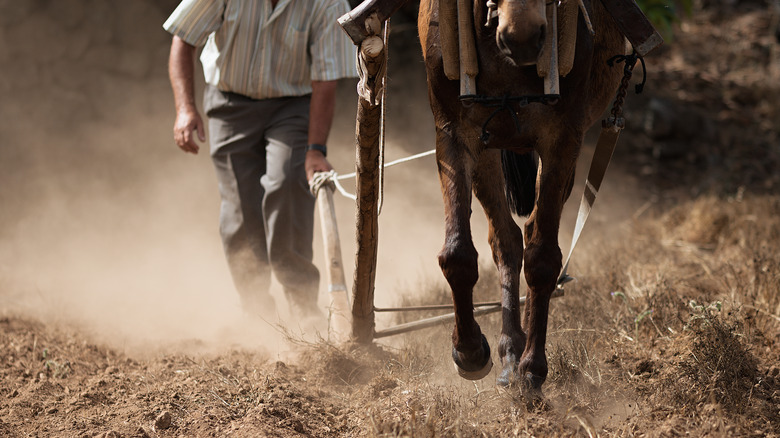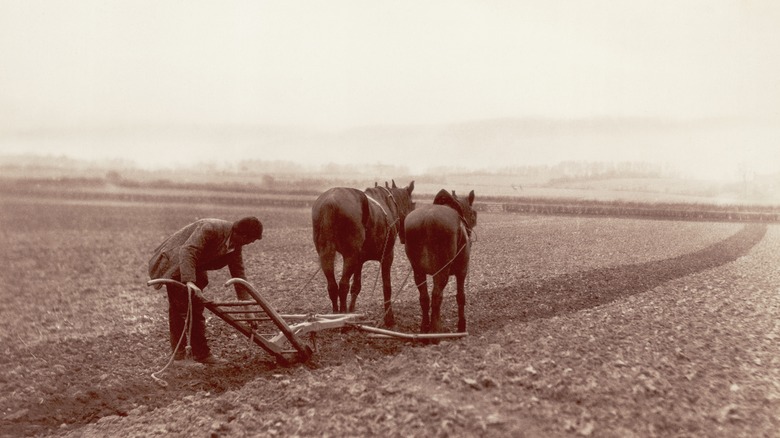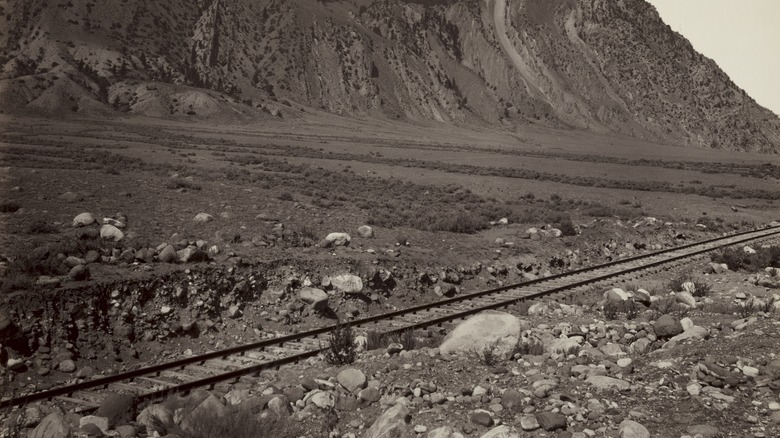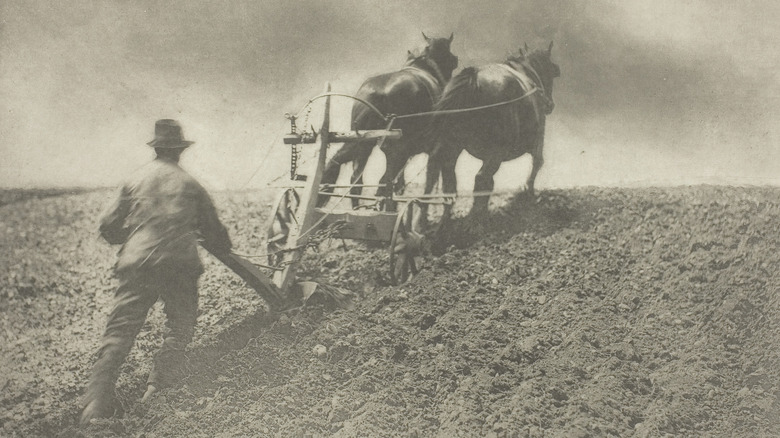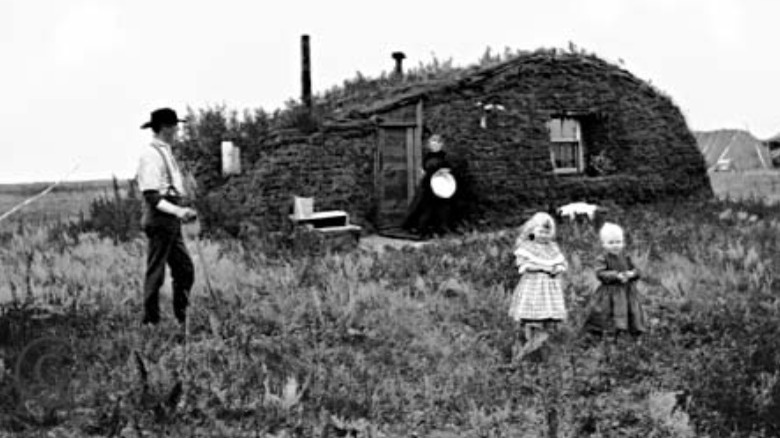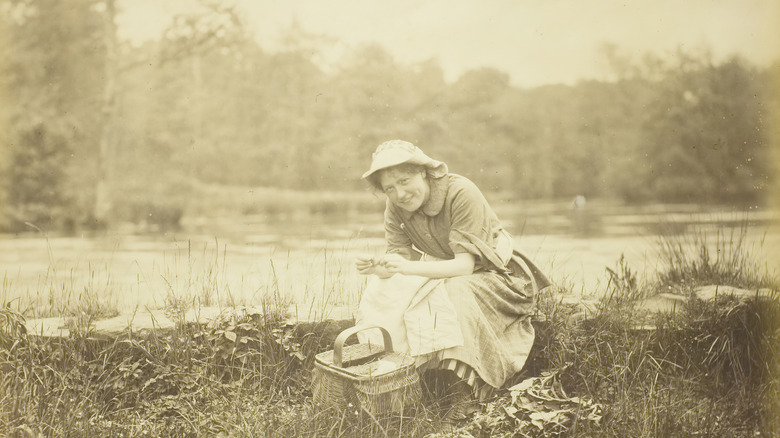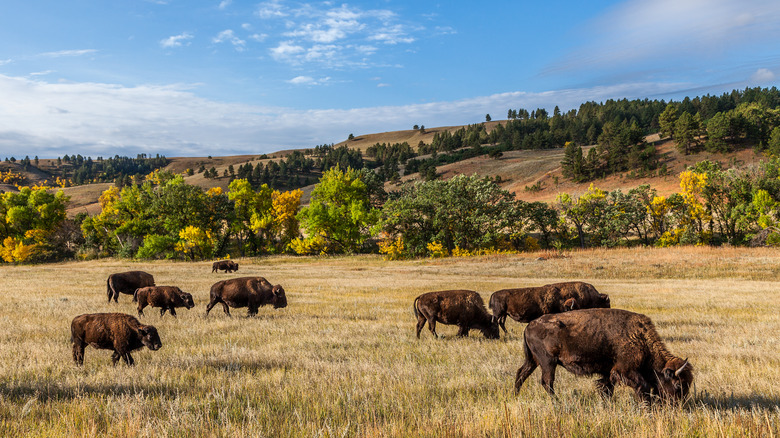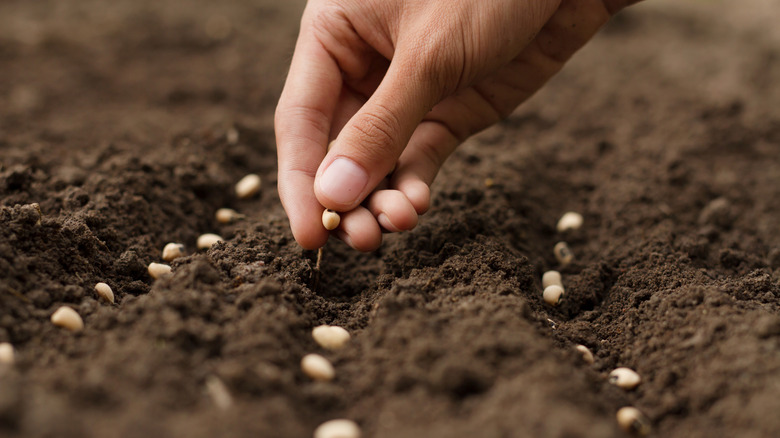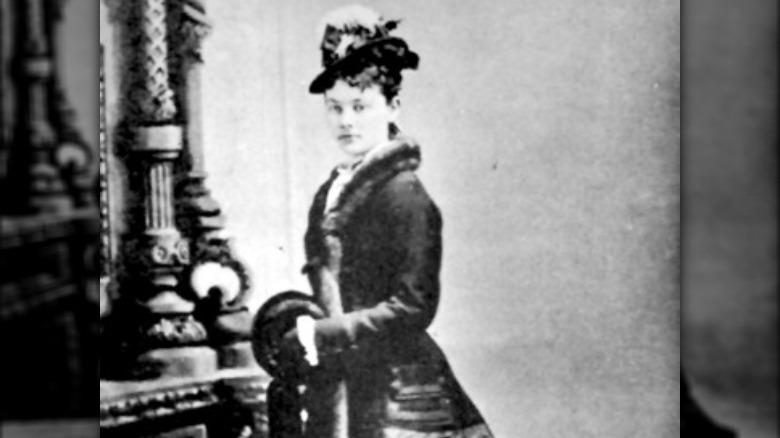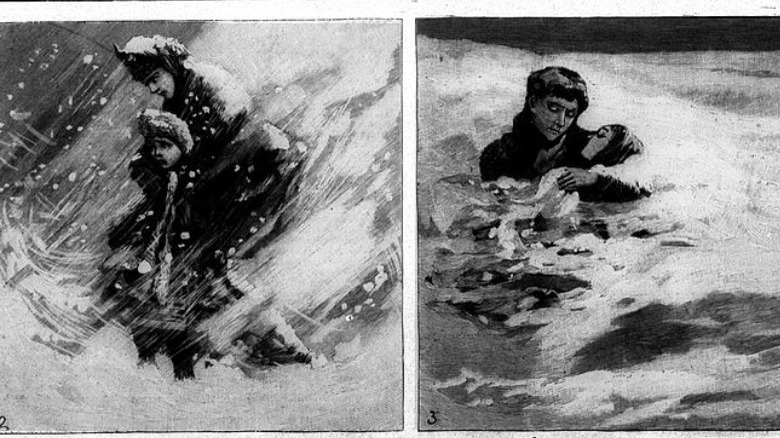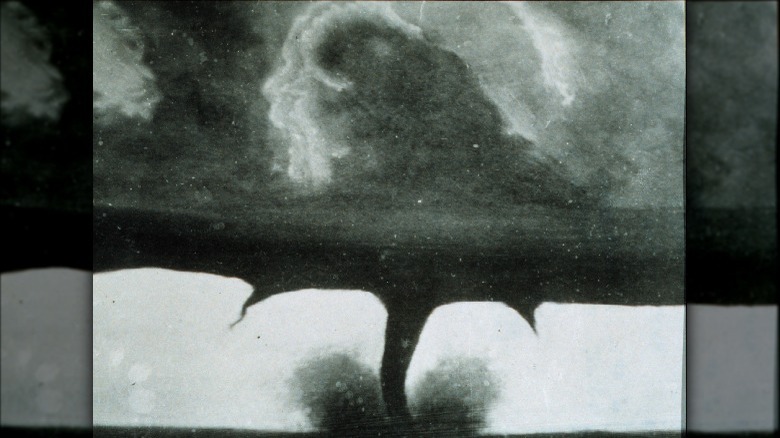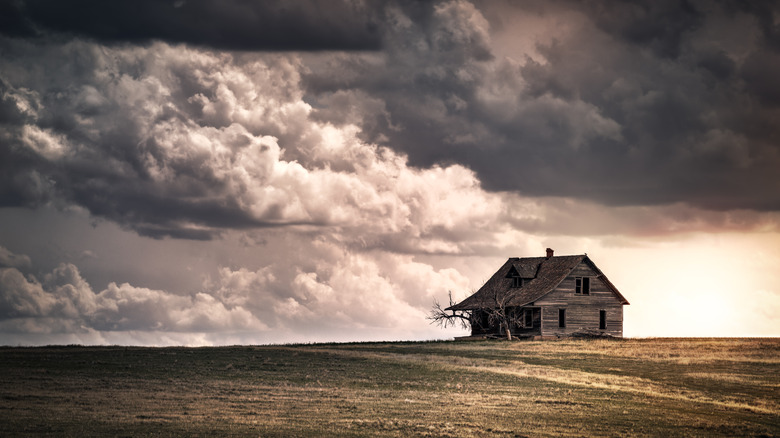What Being A Settler In The 1880s Was Really Like
It's kind of crazy to think about what kind of courage it must have taken to sell everything you owned save for a few treasured possessions, load them into a wagon, and head into a largely mysterious western frontier. Just imagine trundling along day by grueling day, leaving the hustle and bustle of the cities of the eastern seaboard behind and seeing nothing but open plains unfolding ahead.
According to the Smithsonian, America's push west started in 1803 with Thomas Jefferson's $15 million purchase of the Louisiana Territory. (Adjusted for inflation, that's about $263 million in today's money: Not a bad haul for France, who — it could be argued — didn't exactly own the land where indigenous peoples had been living for centuries.)
Those first forays into the wild west had to be equal parts terrifying and awe-inspiring, and as the decades rolled on, it didn't get much easier. In 1862, President Abraham Lincoln established the Homestead Act, which basically promised anyone brave enough to go live in the west a whole bunch of free land. (Who was already living there, well, again, that was considered a rather minor detail.) The National Archives says that there were hundreds of acres up for grabs for a ridiculously low price, so it's no wonder that even into the late 19th century, people were still willing to give it a go. The life they found was almost ridiculously hard, and those men and women depicted in "1883" experienced just the tip of the iceberg.
The requirements of the Homestead Act
When the Homestead Act was signed into law in 1862, it opened up hundreds of thousands of acres for those who were willing to head west, settle on a barren patch of land, and develop it. But it wasn't as easy as just picking a patch of land and saying, "Yep, I'll take this one." According to The National Archives, throwing a hat in the ring and claiming property through the act also meant families were given strict guidelines on how they were going to spend the next few years of their lives.
Once homesteader families had reserved their plot of land and paid the $10 fee, they had exactly six months to pack up and get out to their land. Once they were there, there were more laws.
Families needed to have that barren plot of land as their permanent residence for five years before they could stake an ownership claim. Along with living there — while not having another, back-up legal residence — they also needed to build a home and cultivate a good portion of the land. (There were no set guidelines for this, and whether or not it was good enough for ownership would ultimately be rather subjective.) Also in the fine print? They couldn't leave the land for more than half the year, and given how long it took to get from point A to point B in the 1880s, that meant homesteaders needed to settle in.
Most settlers didn't have the advantages of being near a railroad
It's no secret that horses are one of the coolest animals around, but when it comes time to head from New York to California, most people would prefer something a little more comfortable. In the 19th century, that meant railways.
The Library of Congress says that there was almost a shocking amount of rail lines laid in the latter part of the century. Going into 1871, there was about 45,000 miles of track crisscrossing the growing nation, and by the dawn of the new century, about 170,000 miles had been added to that. Railways were the backbone of the nation, crucial for everything from travel to the shipping and receiving of goods. But they ended up being a double-edged sword, and one that many settlers didn't even get the advantage of.
According to The National Archives, there was a massive anti-railroad sentiment that was gaining steam in the 1870s and 1880s. Powerful rail companies were often gifted millions and millions of acres of prime real estate, and by the time many settlers got there, they found their claims were an average of 30 to 60 miles from the nearest railway. Land immediately adjacent to railways wasn't a part of the ultra-low-low-price scheme of the Homestead Act, which all meant that when families finally got to where they were going, leaving was difficult at best.
Everything rested on the plow ... and side jobs
Part of the requirements each homesteader had to fulfill was working and cultivating a certain amount of land, and it was back-breaking work. In some areas, cultivating claims seemed completely futile, but there was one oft-repeated bit of "wisdom" that suggested the harder a family worked and the more they plowed, the better the weather would get for their crops. It was called "the rain follows the plow," and according to the National Park Service, it was said that prairie worked with a plow would absorb what rain did fall, then — after it had evaporated — more rain would fall. Sounds unlikely? It was, but it was the backbone of settler life throughout the 1880s.
And it led to a lifestyle of 24-hours-a-day toil. Let's look at the Dakotas, with help from North Dakota's official state history. Settlers in the 1880s were still working their land with plows pulled by either a horse or an ox, and those were hot commodities that many people couldn't afford. A single plow horse could cost upwards of $75, and let's put that in perspective.
A bushel of wheat would typically net a family about 40 cents, so many had to take other jobs to make enough money to keep their families afloat. Occupations were varied, and included everything from logging, fishing, and mining to things like carrying the mail, construction, and even bounty hunting (via the University of Washington). All done, of course, alongside full-time farming.
The stages of building a home
According to The National Archives, there was no rest for the weary when they got to the piece of land they were going to be calling home. First, they needed to build a home — and given that much of this land was prairie and grassland, wood was in very short supply.
The answer was — for starters, at least — to dig. Most families created an aptly-named dugout home first, which was exactly that: a hole dug out of the side of whatever hill they could find, and protected by a "door" of sod or sheet metal. There were a few other options, too, says the South Dakota State Historical Society. Claim shanties were temporarily built by families who might be considered the luckiest: These were free-standing, built with sheet metal or tarpaper over a wooden frame. They were all miserable, damp, and dirty places to live, probably not what many had in mind for their grand adventure — especially considering most consisted of a single room that was an average of 10x12 feet.
Families spent months, if not years, living in these dugout homes while they labored away to build a sod home — while working the land, and whatever other jobs they needed to. Sod homes, like the one pictured, weren't much better, and down the road, the end goal was a log cabin of some sort — but it wasn't a quick or easy process.
Sourcing water was a challenge
It's easy to take access to water as something that people just sort of had, but that wasn't the case for settlers staking their claims in the 1880s.
Water, says the South Dakota State Historical Society, was one of the things that homesteaders looked for when they were choosing their plots. Land with easy access to water was among the first to be settled, and as more and more people moved west, things got increasingly difficult. To put things in perspective, The National Archives says that between 1881 and 1885, the Dakota Territory alone welcomed about 67,000 people — and every one of them needed water to survive.
While some were fortunate enough to live near a stream or spring, for others, finding water meant digging a well. Fortunately for 1880s settlers, machinery that would help in this otherwise impossible process was a little more widely available, but still, it wasn't easy. The water table could be anywhere from 40 to 300 feet below the surface, and that's a long way to dig just to get a drink. In the meantime, settlers would gather what rainwater they could, and they had to make it last.
How do you keep warm without firewood?
When settlers moved out west, they undoubtedly knew that many of the creature comforts they were leaving behind just weren't going to be there — but how many expected wood to be on that list of basic necessities?
Settlers didn't just need to get around the lack of wood when it came time to build their homes; they needed to find some other ways to keep warm during the long, cold, dark winter months. According to The National Archives, the 1870s saw the development of stoves that were specifically built to burn hay instead of wood. That was one possibility, but for many, keeping warm meant heading out onto the plains and gathering buffalo poop.
History Nebraska says that settlers would collect and dry both buffalo chips and — because the massive herds of buffalo that once roamed the plains were quickly being devastated by encroaching humans — cow chips. They would then be dried in the sun and stored for use in both heating and cooking, and if that sounds gross, well, it could be worse. The chips, says the Encyclopedia of the Great Plains, didn't spark, so they could be safely used in indoor, open fires. And as far as cooking, they quoted one settler as writing, "Don't feel sorry for us cooking with cow chips. They had their advantages — didn't need to use pepper."
Food on the frontier
While sourcing food may not have been as easy as running down to the grocery store, PBS says that the diet of settlers was surprisingly varied. Basics were usually available at a general store, and that included things like flour, cornmeal, and coffee, although there's a massive footnote to this. Because laws regulating the preparation and sale of food were nonexistent at the time, goods like the aforementioned basics were often stretched with additives like plaster, sawdust, and — in the case of coffee beans — peas and even rocks.
For the most part, anyone living on the frontier in the 1880s needed to grow, hunt, or collect their own food. Families grew everything from salad greens and beans to potatoes and pumpkins, and they collected all kinds of berries from the nearby wilderness. Settler Clarence W. Taber wrote (via the South Dakota State Historical Society) of his family's haul, saying: "Rutabagas, onions, and other root crops, to say nothing of squash, pumpkins, and melons overflowed the bins in our cellar."
Most of those vegetables were dried to be stored through the winter, and in the meantime, diets were also supplemented with whatever families could hunt. Animals like deer and game birds were plentiful, and in order to make it last more than a day or so, it was often pickled, smoked, or brined.
The challenges of frontier medicine
Farms are dangerous places, and that's true for today and in 1880. According to the Oregon Health & Science University, even relatively minor injuries and illnesses could turn deadly, simply because basic medical care was so far away. Anyone living within a day's ride of a doctor could consider themselves fortunate, but even then, it wasn't always an easy journey.
Dr. Bethenia Owens-Adair (pictured) established her practice in Oregon in 1881, and when she wrote her memoirs, it was death-defying stuff. She wrote of being summoned by panicked family members, of nighttime journeys through storms and down raging rivers, and of her own doubts that she would survive some of the trips. Bottom line? Settlers needed to get used to the idea that medical treatment was far, far away.
Doctors — who were often paid in goods and commodities like food and essentials like blankets — needed to be skilled in everything from bringing people into the world to seeing them out. While some — like Owens-Adair — worked out of offices, others were what The Western Journal of Medicine calls "medical circuit riders." These were doctors who would leave their homes to follow a weeks-long route through remote settlements, and along the way, they'd spend a few nights with their patients before moving on to the next area and attending to anyone who needed care.
Storms could present catastrophic problems
Storms can be devastating today, and those that swept across the west and midwest in the 19th century were nothing short of catastrophic. United States Department of the Interior surveys from 1946 looked at a phenomenon that had devastated Utah: cloudburst flooding. These storms seemed to reach their peak in the 1880s, and in a nutshell, they were sudden, massive downpours of rain that caused severe flooding when they overloaded the capacity of streams and rivers.
Blizzards were deadly, too: For a heartbreaking example, let's look at the 1888 storm dubbed the "Schoolchildren's Blizzard," named for the hundreds of children who died in it. According to History, there was no warning that a blizzard was going to be moving in, and when temperatures dropped to -40 Fahrenheit in some places, children who were walking home from school were killed in the cold, snow, and blinding winds. The blizzard covered an area that included Nebraska all the way up to South Dakota and Minnesota.
Stories from the blizzard are unthinkably heartbreaking. When Loie Royce tried to move her three students from her schoolhouse to her home — a distance of just 90 yards — they got lost in the blinding snow. All three children died, and Royce suffered such severe frostbite that she lost both feet. The MinnPost says the death toll is unknown, but is estimated to be up to 500 — and that's not counting those who died afterwards, many from pneumonia or infections that set in when frostbitten limbs were amputated.
Tornadoes were an ever-present, mysterious threat
There's no denying that the tornado scene from "The Wizard of Oz" is the sort of thing that scars a kid for life, but here's the thing: Tornadoes had been a very real threat to settlers for decades, and at the time, even the professionals didn't know too much about them. (The Smithsonian says that it was only in 1948 that meteorologists set to figuring out how to predict tornadoes.)
Laura Ingalls Wilder describes the approach of an 1882 tornado in "These Happy Golden Years," writing (via The National Archive) that a family they knew had just gathered materials for building a home when "one of the children noticed a small dark object high in the clear sky overhead ... They saw that it was a door ... It was the front door of this man's vanished claim shanty."
Stories of tornadoes are found throughout the decade. The National Weather Service recorded a series of tornadoes tearing through Illinois in April of 1880, even as Missouri saw what the White River Valley Historical Quarterly called a "tornado outbreak." 1883 saw a series of tornadoes lay waste to much of Minnesota, and those are just a few of many. Given how frightening a tornado is today, it's difficult to imagine what it must have been like to watch one bearing down on your family's simple sod house.
Prairie madness
Prairie madness, says Psychology Today, was a sort of blanket term for all of the mental health struggles that settlers faced, and they ranged from things like depression to anxiety and — as chronicled in Laura Ingalls Wilder's book "These Happy Golden Years" — the occasional urge to murder everyone in the family. Prairie and frontier life wore on a person's psyche for any number of reasons: there was the long periods of isolation and loneliness, the potential for illness, injury, and death to be lurking around every corner, the constant worry about food, water, and basic necessities, and interestingly, while the weather gets a shout-out, too, there's one thing in particular that's credited for being particularly madness-inducing.
A paper presented at a 2018 conference of the Society for Historical Archaeology suggested that the relentless sound of the wind could have been a major trigger for everything from insomnia to the many recorded accounts of uncharacteristically violent behavior. That's supported by research from Australia and Germany (via The Age) that seems to confirm that the wind has negative impacts on mood, behavior, and mental health.
It's no wonder, then, that people have been writing about — and condemning — the wind for as long as the written word has been around (via Lithub). From Hippocrates to Shakespeare, the wind has been maddening — and perhaps nothing sums up what prairie settlers would have experienced better than this English proverb: "When the wind is in the east, 'tis good for neither man nor beast."
